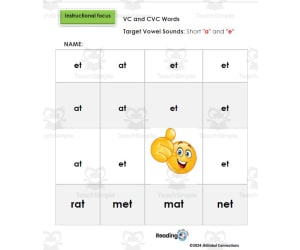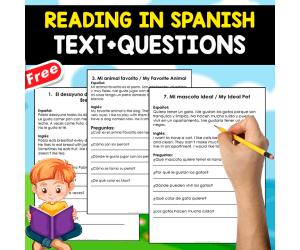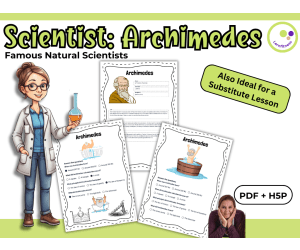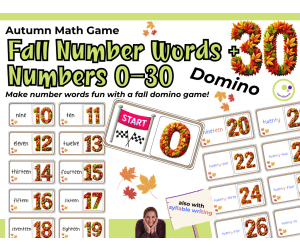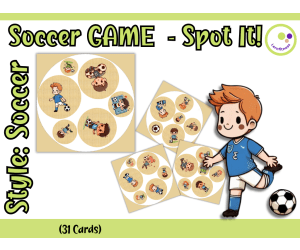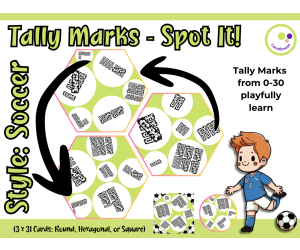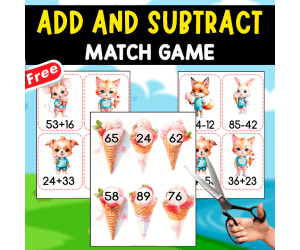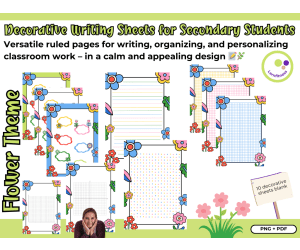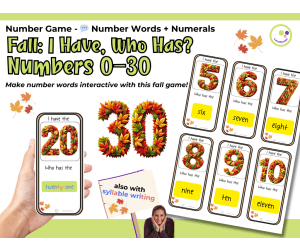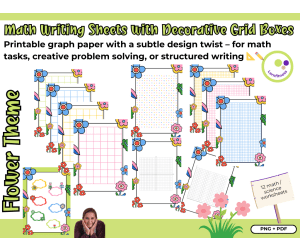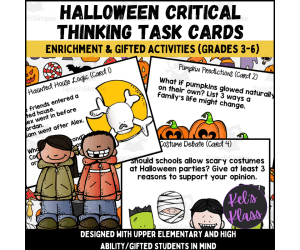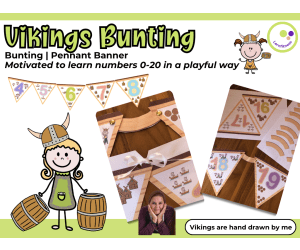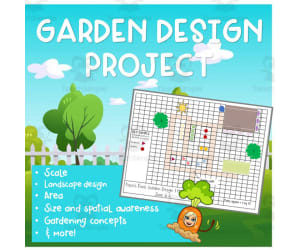2,925 products added recently
Math Projects
Support mathematical understanding with projects that apply concepts to real-life scenarios. This collection includes statistical studies, geometry in design, and budget planning exercises. By integrating these math projects into your teaching, you can make math relevant and engaging.
CUT-OUT ACTIVITY | 3 FREE FUNNY PAGES_J
Creative Arts, STEM, Special Resources, Montessori, Speech Therapy, Life Skills, Early Learning, Elementary, Homeschool Resources, Not Grade Specific, Pre-K, Activities, Worksheets & Printables, Coloring Pages, Worksheets
CUT-OUT ACTIVITY | 3 FREE FUNNY PAGES THIS RESOURCE HAVE 3 FUNNY CUT-OUT PAGES. INTRODUCTION: Welcome to EDITORIAL ARENAS EDUCATIVAS! We specialize in producing diverse educational tools to support children's learning journeys. Be sure to browse our store for reading, writing, math, and Spanish resources designed to make learning fun and impactful. MAIN DESCRIPTION; 1) What educational standards were used as the basis for creating this material? This document was not developed based on any specific standard. 2) Who is the creator of this resource and how should it be cited? The creator of this document is EDITORIAL ARENAS EDUCATIVAS. 3) Is this resource available for free or does it require a purchase? Because we vocationally work for the education of thousands of students, we are offering this document for free. 4) This resource is for individual use only; what restrictions apply to its redistribution or sale? We ask that you share our link so more people can download our resource or recommend our store. It would help us greatly. SECONDARY AND COMPLEMENTARY INFORMATION: 1) What specific skills are developed using this resource? Students will be able to develop their attention, concentration, creativity, and imagination skills. It will also allow students to develop their cognitive skills such as comprehension, analysis, and others. 2) Who is the ideal audience for this document? This document and/or teaching resource is primarily intended for young students, meaning those between the ages of 5 and 12, in other words, students in early childhood and/or primary education. However, it can also be used by the general public if required. 3) What recommendations are there for making the most of this resource? To make the most of this resource, I recommend first analyzing it, then looking at the specific topic your student needs to learn and assess whether my resource addresses it. I also ask you to consider how you will print it. 4) Is this material up to date with the latest educational changes? Yes, this material primarily addresses all learning theories about children, which tell us that children should learn in an educational and fun way.
Author EDITORIAL LAURA EDUCA
Rating
Tags FREE, FREE RESOURCES, CUT OUT, PRINTABLES, WORKSHEETS, ANIMALS, MAZES
Emoji VC and CVC RAN Word Play
ELA, Language Development, Pre-Reading, Preschool, Grade 1, Activities
Introduction: This packet contains four RAN charts with a surprise emoji to make learning VC and CVC letter patterns a bit more engaging and interactive. Objective: to help students quickly recognize and pronounce VC letter patterns and support bleding CVC words. Order, Outline and Steps: Chart 1: Focuses on VC patterns with short ‘a’ and ‘e’ sounds. Chart 2: Targets VC patterns with short ‘e’ and ‘i’ sounds. Chart 3: Targets VC letter patterns with short 'a' and ' u' Chart 4: CVC words wtih short 'a' and 'e'. All charts have CVC words with a mix of real and nonsense words for varied practice. Grades or Ages: RAN charts are ideal for students beginning to learn phonics. Ideal for kinder/ first grade or reading intervention K-3. Implementation Format: The Ran charts can be used for individual practice or part of guided reading lessons. Answer Keys: Not applicable, as the charts are for pronunciation and decoding practice. How to Use and Variations: Students can work through the charts sequentially or focus on specific vowel sounds they find challenging. Improve auditory discrimination skills with RAN charts . For variation, let students act out their own emoji after they decod all the words. Standards: RAN, or Rapid Automatized Naming, involves quickly naming a sequence of random letters, numbers, objects, or colors, and is a predictor of reading ability. These charts support foudational reading standards. File Types: PDF format. Number of Pages: There are four pages, one for each RAN chart.
Author JkGlobal Connections- Structured Literacy for Reading Success
Tags RAN, Reading Fluency, Blending Vc And Cvc Words , Nonsense Words, SOR
10 FREE SPANISH TEXT | READING AND COMPREHENSION
Foreign Languages, Spanish, Language Development, ELA, Reading, Reading Comprehension, Adult Education, Early Learning, Elementary, High School, Homeschool Resources, Middle School, Not Grade Specific, Activities, Teacher Tools, Worksheets & Printables
10 FREE SPANISH TEXT | READING AND COMPREHENSION INFORMATION OF THE AUTHOR: Welcome to EDITORIAL ARENAS EDUCATIVAS! We specialize in producing diverse educational tools to support children's learning journeys. Be sure to browse our store for reading, writing, math, and Spanish resources designed to make learning fun and impactful. MAIN INFORMATION OF THIS SPANISH RESOURCE: 1) What specific skills are developed using this resource? Students will be able to develop their attention, concentration, creativity, and imagination skills. It will also allow students to develop their cognitive skills such as comprehension, analysis, and others. 2) Who is the ideal audience for this document? This document and/or teaching resource is primarily intended for young students, meaning those between the ages of 5 and 12, in other words, students in early childhood and/or primary education. However, it can also be used by the general public if required. 3) What recommendations are there for making the most of this resource? To make the most of this resource, I recommend first analyzing it, then looking at the specific topic your student needs to learn and assess whether my resource addresses it. I also ask you to consider how you will print it. 4) Is this material up to date with the latest educational changes? Yes, this material primarily addresses all learning theories about children, which tell us that children should learn in an educational and fun way. 5) What printing format guarantees the best results? I recommend printing this document in PDF format. I would also ask you to carefully check whether you have a color or black and white printer. SECONDARY AND COMPLEMENTARY INFORMATION: 1) What main topic does the resource cover? This document has been developed to address a basic topic that children in kindergarten through elementary school should master. This document will also be helpful to the general public who want to learn. 2) What version does this document correspond to? This educational resource is designed in PDF format, which will make your download experience much simpler and easier to use. 3) Is the material designed in color or black and white? This document has been designed in color (if required) or is sometimes created in black and white to make your learning experience easier. OTHERS FREE RESOURCES FOR YOU: SPANISH COLORS: https://teachsimple.com/product/spanish-color-activity-cut-and-paste SPANISH VEGETABLES: https://teachsimple.com/product/spanish-vegetables-flashcards-12-free-flashcards ANIMAL HOUSES: https://teachsimple.com/product/animal-houses-in-spanish-3-free-worksheets
Author EDITORIAL LAURA EDUCA
Rating
Tags FREE, FREE RESOURCES, SPANISH, ESPAÑOL, ESPANOL, SPANISH TEST, SPANISH RESOURCES
Archimedes – Scientist Profile and Comprehension Activities PDF + H5P
Life Sciences, Science, STEM, Social Studies, Biographies, Inventors, Basic Science, Physics, Chemistry, Math, Grade 6, 7, 8, 9, Worksheets, Worksheets & Printables, Quizzes, Quizzes and Tests, Teacher Tools, Projects, Activities
Archimedes – Scientist Profile and Comprehension Activities Informational Text, Student Tasks & Quiz (PDF, DOCX, H5P) ⚖️🧠 This resource introduces students in grades 7–10 to Archimedes, one of the most influential figures in early science. Best known for his work on buoyancy and the principle of density determination for irregular objects, Archimedes connects classical thought with key scientific concepts still taught today. The material combines factual reading with structured tasks. It can be used flexibly: in science lessons, for cross-curricular units, or as an easy-to-run activity in substitute teaching. Students read a short informational text, fill in a profile worksheet, complete quiz questions, and – if time allows – create their own questions to exchange with a partner. What’s included: Informational text about Archimedes Profile worksheet for comprehension and reflection Answer key for the profile Quiz questions with solutions Two extension tasks: – Create your own questions – Exchange and answer a partner’s questions File formats: – Printable PDF – Editable DOCX (text only) – Interactive H5P version (text-based, no images) In the classroom: I’ve used this kind of resource in regular science lessons as well as in non-specialist cover lessons. The tasks are clear enough for independent work and provide a good balance between reading, writing, and critical thinking. The H5P version allows for easy digital use on learning platforms, especially when students work from home or on devices in class. It’s also great for differentiation: stronger students can work on their own questions, while others use the glossary or reread sections to complete the basics. Whether you use it to introduce Archimedes in physics or to practice nonfiction reading strategies, this is a flexible resource that’s ready to go with little prep. Have fun exploring the world of science with your students! Warmly, Lernfitness Did You Know? I teach with a certified therapy dog, and together we focus on creating a positive and inspiring learning environment.
Author Lernfitness
Rating
Tags Science, Famous Scientists Lesson, H5P, Interactive Science Exercises, STEM, History, Scientists, Chemistry, Archimedes, Scientific Concepts
FREE FLAP BOOK OF MULTIPLICATION | 1 - 10
Division, Multiplication and Division, Math, Multiplication, Early Learning, Elementary, Homeschool Resources, Not Grade Specific, Pre-K, Games, Activities, Projects, Worksheets, Worksheets & Printables
FREE FLAP BOOK OF MULTIPLICATION | 1 - 10 SUMMARY OF THIS PRODUCT: What is the name of the document?: FLAP BOOK 1-10 How many pages does it include?: 10 In what format is it available (PDF, Word, PPT)?: PDF Is it in color or black and white?: BLACK AND WHITE TAGS: Multiplication, Flap Book, Math, Math resources. MAIN DESCRIPTION OF THIS PRODUCT: What is the name of your product and what makes it special? This beautiful product is called “FLAP BOOK OF THE MULTPLICATION”, and it is very special because it was carefully designed or compiled. With this educational resource, we want students to learn with enthusiasm and fun, because we believe learning is fun. How many pages are included in this resource? This fabulous document contains the following number of pages: 10 What size is it designed in (A4, letter, etc.)? This resource is designed in A4 format and compiled as a PDF. This makes downloading and printing simple and convenient, and PDFs are also easy to store and carry anywhere. PDF A4 ABOUT THE AUTHOR: At EDITORIAL ARENAS EDUCATIVAS, we work every day to create educational materials that turn learning into a fun game. Our mission is for every child to enjoy the process of learning. Visit my educational store and discover all the resources we have ready for you. SECONDARY AND COMPLEMENTARY INFORMATION: Who can use it best (teachers, parents, students, therapists, homeschoolers)? We are all part of education. Whether you are a teacher, parent, student, or therapist, this document can adapt perfectly to your learning goals, depending on your creativity. What additional materials are recommended (printer, scissors, markers, etc.)? The more immersed students are in learning, the greater their results. That’s why it’s ideal to complement this resource with pencils, crayons, markers, and even other art tools. What outcome, benefit, or transformation can the user expect? With this fabulous resource, students will first understand that learning is easy and fun, and second, they will strengthen their knowledge and skills.
Author EDITORIAL LAURA EDUCA
Rating
Tags FREE, FREE RESOURCES, MATH, MATH RESOURCES, MULTIPLICATION, FLAP BOOK
Fall Domino Game – Numbers and Number Words 0–30
Holiday & Seasonal, Language Development, ELA, Special Resources, Special Education Needs (SEN), Math, Early Math, Numbers, Seasons, Fall, Preschool, Grade 1, 2, 3, 4, 5, Activities, Games, Worksheets & Printables, Quizzes and Tests, Teacher Tools, Quizzes, Projects, Flashcards, Centers
Fall Domino Game Numbers 0–30 and Number Words This autumn domino game is a hands-on way for students to practice both numbers and number words from 0 to 30. I introduced it during the fall term with my grade 1 class, and the students immediately understood the rules because it follows the familiar domino format. The seasonal design added a nice touch, but the main benefit was the repeated practice with connecting numbers and words. The set includes 68 cards in total, with two different versions. One version shows the standard number words, while the second version breaks the words into syllables. I noticed that the syllable version was especially helpful for younger readers or for students who still found longer number words challenging. Words such as “seventeen” or “twenty-four” became easier to read and pronounce when broken down into smaller parts. The game can be adjusted by number range, which makes it easy to differentiate. With beginners, I often start with 0–10 so that the game feels manageable. Later I expand the set to 0–20, and eventually the full 0–30 for more advanced groups. Because of this flexibility, the same set can be reused throughout the year with different levels of learners. There are several ways to play. In small groups, students take turns matching numbers with the correct number words, trying to be the first to play all their cards. In a whole-class setting, I sometimes spread the cards across the floor and let students work together to build one long domino chain. This version turns the game into a collaborative activity and gets everyone moving while still practicing number recognition. Preparation is simple. Print the cards, cut them apart, and laminate them if you want to reuse the set in future years. I keep mine in small envelopes labeled with 0–10, 0–20, and 0–30 so I can quickly pull the right range for each group. The activity works well in math centers, small group rotations, or even as a fun review during October. Warm regards, Lernfitness Did You Know? I teach with a certified therapy dog, and together we focus on creating a positive and inspiring learning environment.
Author Lernfitness
Rating
Tags ESL, Game, Educational Card Games, Elementary, Math Game, Numbers, Counting, Matching Cards, Domino, Fall
Soccer Game – Find the Match! Spot It! Style with Hand-Drawn Cliparts
Montessori, Math, Early Math, Special Resources, Common Core, Holiday & Seasonal, Social Emotional Learning (SEL), Speech Therapy, Special Education Needs (SEN), Social Skills, Preschool, Infant, Toddler, Kindergarten, Grade 1, 2, 3, Activities, Games, Worksheets & Printables, Task Cards, Quizzes and Tests, Teacher Tools, Quizzes, Projects, Flashcards
Soccer Game – Find the Match! Spot It! Style with Hand-Drawn Cliparts Similar to Dobble / Spot it! A quick-thinking visual game for elementary learners – perfect for brain breaks, warm-ups, or station work ⚽🧠 This printable matching game is built around a simple idea: every two cards share exactly one image – and the goal is to find it faster than your opponent! Designed in a soccer theme and illustrated with my own hand-drawn clipart, this version adds a playful and sporty twist to the classic Dobble/Spot It! concept. You’ll receive two full sets of 31 cards each – in both round and square formats. Each card includes six different soccer-related illustrations (balls, shoes, trophies, whistles, and more). Whether you're working on visual attention, comparison, or just want to offer something fun and interactive, this game is a low-prep favorite. What’s included: 62 cards in total (2x 31-card sets) 2 formats: round and square (easy to cut) All images are original soccer-themed clipart Clear instructions included PDF format for printing and laminating How I’ve used it in the classroom: This type of game has worked really well for me during transition times or as part of a classroom “focus station.” It’s quick to explain, easy to set up, and even young learners who don’t read yet can join in. The competitive element keeps it exciting, but the visual search also supports focus and attention. You can play in small groups, pairs, or even adapt the cards for solo use. The laminated version holds up well over time, and I often keep a copy in our class game drawer. A simple, sporty way to bring energy and focus into your classroom – and a nice break from worksheets. Print, cut, and play – no prep needed, and lots of learning packed into a simple activity. Warm regards, Lernfitness Did You Know? I teach with a certified therapy dog, and together we focus on creating a positive and inspiring learning environment.
Author Lernfitness
Rating
Tags Math, Foreign Languages, Game, Spot It, Educational Card Games, Visual Math Activity, Find The Match, Soccer, Soccer Game, Elementary
Tally Marks Game – Learning to Count with a Soccer Twist
Montessori, Math, Numbers, Early Math, Counting, Algebra, Decimals, Science, STEM, Special Resources, Preschool, Grade 1, 2, 3, 4, 5, 6, Activities, Games, Worksheets & Printables, Task Cards, Quizzes and Tests, Teacher Tools, Quizzes, Projects, Flashcards
Tally Marks Game – Learning to Count with a Soccer Twist Similar to Dobble / Spot it! A hands-on matching game for grades 1–6 (PDF – Dobble / Spot It! style) ⚽📊 This resource is a playful way to help students practice tally marks while staying active and engaged. The game is based on the popular “Find the Twin” concept (similar to Dobble or Spot It!) and helps children recognize and count tally lines quickly and confidently. Each card shows six symbols – including different tally mark patterns – and players have to find the matching pair between any two cards. The game encourages concentration, quick visual comparison, and number recognition, all while reinforcing how tally marks work. What’s included: 93 cards total → 3 full sets with 31 cards each 3 versions: → round cards → cut-friendly square cards → hexagonal cards All with clear, child-friendly visuals Instructions for flexible classroom use How I’ve used it in class: I like to use this game in small math stations or as a warm-up activity. It’s also a favorite for early finishers or during quieter times when a bit of movement and interaction is helpful. You can laminate the cards for long-term use, or simply print them on heavier paper. The game works in pairs or small groups – and students pick up the rules quickly. Beyond basic counting, the game helps introduce how we group numbers for clarity, which is a useful step toward early data handling and bar graphs. And the sporty theme adds just the right amount of energy. Print, cut, and play – no prep needed, and lots of learning packed into a simple activity. Warm regards, Lernfitness Did You Know? I teach with a certified therapy dog, and together we focus on creating a positive and inspiring learning environment.
Author Lernfitness
Rating
Tags Math, Foreign Languages, Game, Spot It, Educational Card Games, Visual Math Activity, Find The Match, Tally Marks, Tally Charts
SUPER BUNDLE | Multiplication Activities 1-DIGIT | +180 PAGES
Math, Multiplication and Division, Multiplication, Early Learning, Elementary, Homeschool Resources, Middle School, Not Grade Specific, Games, Activities, Projects, Workbooks, Worksheets & Printables, Worksheets
SUPER BUNDLE | Multiplication Activities 1-DIGIT | +180 PAGES THIS SUPER PACK HAVE MORE THAN 180 PAGES WITH ACTIVITIES OF THE MULTIPLICATION BY 1-DIGIT. INFORMATION OF THE AUTHOR: Thank you for choosing EDITORIAL ARENAS EDUCATIVAS! Our mission is to deliver a variety of learning resources that make education enjoyable and effective for children. Don't forget to visit our store to explore products for reading, writing, math, and Spanish language skills. MAIN DESCRIPTION OF THIS RESOURCE: 1) Is the material designed in color or black and white? This document has been designed in color (if required) or is sometimes created in black and white to make your learning experience easier. 2) What age range is appropriate for this resource? Our publishing company is dedicated to creating resources for young children between the ages of 3 and 12, as well as for older students or anyone who needs them. 3) What keywords best describe this resource? We can tag this product with keywords such as: teaching resource, resources, materials, teaching materials, worksheets, educational worksheets, worksheets for children. 4) What instructions should I follow for proper printing? I recommend that you first download this document, then check if your printer is capable of printing, and also verify that you have the appropriate document size. SECONDARY AND COMPLEMENTARY INFORMATION: 1) What recommendations are there for making the most of this resource? To make the most of this resource, I recommend first analyzing it, then looking at the specific topic your student needs to learn and assess whether my resource addresses it. I also ask you to consider how you will print it. 2) Is this material up to date with the latest educational changes? Yes, this material primarily addresses all learning theories about children, which tell us that children should learn in an educational and fun way. 3) What printing format guarantees the best results? I recommend printing this document in PDF format. I would also ask you to carefully check whether you have a color or black and white printer. 4) What recognition or endorsement does the author of this material have? This document has been prepared by EDITORIAL ARENAS EDUCATIVAS, and we guarantee that this document has been carefully selected, ensuring that your students have a fun and successful learning experience.
Author EDITORIAL LAURA EDUCA
Rating
Tags FREE, FREE RESOURCES, BUNDLE, PACK, MULTIPLICATION, DIVISION, MATHS, MATH RESOURCES
ADDITION AND SUBTRACTION | INTERACTIVE GAME FOR MATCHING
Early Math, Math, Numbers, Addition and Subtraction, Addition, Subtraction, Early Learning, Elementary, Homeschool Resources, Not Grade Specific, Games, Activities, Projects, Flashcards, Worksheets & Printables
ADDITION AND SUBTRACTION | INTERACTIVE GAME FOR MATCHING GENERAL DESCRIPTION OF THIS PRODUCT: What format is it in (digital, printable, PDF, A4, letter)? This fun and engaging resource is designed in A4 format and has been converted to PDF, making it easy to use and carry anywhere: PDF Is the design in full color, black and white, or mixed? This document includes both black and white and color versions, making it more creative and appealing. You also have the freedom to print it in whichever style you prefer: COLOR What type of material is it (book, workbook, activity pack, posters, flashcards)? EDITORIAL ARENAS EDUCATIVAS creates a variety of materials such as packs, worksheets, games, and assessments. This resource belongs to one of those categories: GAME For what ages, levels, or grades is it designed? My specialty is creating educational resources for children, especially for preschool (ages 3–5) and primary (ages 6–12). Sometimes, I also create Spanish resources for learners of all ages. ABOUT THE AUTHOR: At EDITORIAL ARENAS EDUCATIVAS, we specialize in designing high-quality educational materials. We want every child to discover that learning can be both entertaining and creative. I invite you to explore my educational store and discover the wide collection of resources available for your classroom or home. BASIC INFORMATION OF THIS MATH RESOURCE: The name of the document: Addition and Subtraction Game The total number of pages: 10 pages The format (PDF, Word, PPT): PDF Whether it is in color or black and White: Color. SECONDARY OR EXTRA INFORMATION OF THIS RESOURCE: Who can use it best (teachers, parents, students, therapists, homeschoolers)? We are all part of education. Whether you are a teacher, parent, student, or therapist, this document can adapt perfectly to your learning goals, depending on your creativity. What additional materials are recommended (printer, scissors, markers, etc.)? The more immersed students are in learning, the greater their results. That’s why it’s ideal to complement this resource with pencils, crayons, markers, and even other art tools. What outcome, benefit, or transformation can the user expect? With this fabulous resource, students will first understand that learning is easy and fun, and second, they will strengthen their knowledge and skills.
Author EDITORIAL LAURA EDUCA
Rating
Tags FREE, FREE RESOURCES, MATH, MATH RESOURCES, ADDITION, SUBTRACTION, ADDITION AND SIBTRACTION
Fall Number Flashcards – 0–30 Memory and Sequencing Games
Holiday & Seasonal, ELA, Special Resources, Special Education Needs (SEN), Seasons, Fall, Math, Early Math, Numbers, Counting, Preschool, Grade 1, 2, 3, 4, Activities, Games, Worksheets & Printables, Quizzes and Tests, Teacher Tools, Quizzes, Projects, Flashcards, Word Problems, Centers
Fall Numbers Memory Game Bring autumn fun into your math lessons! This set of fall-themed flashcards gives students repeated practice with numbers from 0 to 30 in a playful and flexible format. I first made these for my kindergarten class, when many of my students still needed support with recognizing numbers and putting them in the right order. The cards worked well because they could be used in so many different ways without having to prepare something new each time. There are 228 cards in total, divided into six full sets with different colored borders. The colors make it easy to keep groups organized, since each table can use a separate set without mixing the cards together. Each card shows a single number in a large, clear font, which helps beginning learners and also supports students who struggle with visual distractions. The cards can be used for memory or matching games, where students flip over two at a time and try to find pairs. Another favorite activity in my class has been sequencing: students work together to lay the cards out from 0 to 30. For more active lessons, we sometimes spread the cards on the floor and have students “walk” the numbers in order, which adds movement to the practice. I also use the cards as simple flashcards, holding them up for quick recognition drills, or handing one card to each student and asking the group to line up in numerical order. With partners, students have created their own math problems using the numbers they draw, which adds a layer of challenge for more advanced learners. Differentiation is built in, since you can choose how many numbers to include. With beginners, I usually work with 0–10. As students grow more confident, I extend to 0–20 and eventually the full 0–30. Adding a timer or encouraging students to say each number out loud when they play can make the activity even more engaging. Preparation is straightforward: print the set you want, cut the cards, and laminate if you plan to reuse them. I keep each set in small envelopes or bags so they are ready for math centers, group games, or quick warm-ups. The fall design adds a seasonal touch, but the number practice is useful all year long. Warm regards, Lernfitness Did You Know? I teach with a certified therapy dog, and together we focus on creating a positive and inspiring learning environment.
Author Lernfitness
Rating
Tags Foreign Languages, Game, Educational Card Games, Elementary, Fall, Memory, Numbers, Counting, Autumn, Math
Decorative Writing Sheets for Secondary Students
Science, Seasons, Holiday & Seasonal, Summer, Spring, Common Core, Handwriting, Writing, ELA, Math, Homeschool Templates, Activities, Worksheets & Printables, Worksheets, Projects, Classroom Decor, Bulletin Boards, Posters, Teacher Tools, Templates, Coloring Pages
Decorative Writing Sheets for Secondary Students Versatile ruled pages for writing, organizing, and personalizing classroom work – in a calm and appealing design 📝🌿 PNG + PDF These decorative worksheets were created with older students in mind. They combine a clean, thoughtful layout with subtle design elements that make them suitable for many classroom contexts – from creative writing to structured math problems. Each page features light, subject-neutral decorations and matching rulings. The rulings are clearly visible but not too dominant, and their colors are coordinated with the overall design. This small detail gives the pages a more polished, motivating look – without distracting from the actual task. What’s included: A selection of printable decorative writing sheets with lines All designs with age-appropriate, calm visuals Rulings in matched color tones for a cohesive appearance PDF format – great for print or digital notebooks (e.g. GoodNotes, Notability) PNG Format Ideas for classroom use: I’ve used these kinds of pages in various ways – for summaries, vocabulary practice, reflections, and even small-scale presentations. Some students appreciate having a “special” page to write on for final drafts or project titles. They’re also useful for open tasks: students might choose how to use the space, which supports creative thinking and independence. Because the sheets are not content-bound, they work well across subjects. Whether you’re teaching language arts, science, or social studies, you can adapt them to your lesson. I’ve even let students use them for personal notes or as covers for their portfolios. They also serve well during quieter phases, in tutoring settings, or as part of personalized learning folders. And for digital classrooms, students can fill them out using a stylus or keyboard. A simple, flexible resource – and a small visual upgrade that shows students their work matters. Best, Heike from Lernfitness Did You Know? I teach with a certified therapy dog, and together we create a positive and welcoming learning environment. 🐶
Author Lernfitness
Rating
Tags Blank Writing, Activity Sheets, Spring, Summer, Decorative Pages, Writing, Drawing, Custom Classroom Materials, Seasonal, Worksheets
Fall I Have, Who Has? Game – Numbers and Number Words 0–30
Holiday & Seasonal, Language Development, ELA, Special Resources, Special Education Needs (SEN), Math, Early Math, Numbers, Seasons, Fall, Preschool, Grade 1, 2, 3, 4, 5, Activities, Games, Worksheets & Printables, Quizzes and Tests, Teacher Tools, Quizzes, Projects, Centers, Read Alouds
Fall I Have, Who Has? Game – Numbers and Number Words 0–30 This autumn version of “I Have, Who Has?” gives students practice with numbers and number words from 0 up to 30 . I like to use it in October, when the seasonal design adds a bit of variety to our math centers. The familiar format makes it easy for students to understand, and the game naturally gets everyone involved. The set includes two complete versions. One uses standard number words, while the other shows the words broken into syllables for students who need extra support with reading. That option has been especially helpful for children who find longer number words like “seventeen” or “twenty-three” difficult to read in one piece. You can decide how many cards to use depending on the group. For beginners, I usually stop at 0–10. As students gain confidence, I extend to 20 and then to 30. This makes the same resource usable across different levels without much extra planning. Playing is straightforward. The student with the start card begins by saying, “I have zero. Who has one?” The next student responds and the chain continues until the last card is read. Because students must listen carefully and wait for their turn, the game encourages attention, listening skills, and turn-taking alongside number practice. I have used this game in whole-class lessons, where everyone sits in a circle and plays together, and in small groups for targeted practice. It also works well for early finishers since once they know the rules, they can play independently. Preparation is simple. Print the cards, cut them apart, and laminate if you plan to reuse them. I store each set in a small envelope labeled with the range (10, 20, 30), so it’s easy to grab the version I need. This activity combines math and literacy practice with teamwork in a way that feels light and seasonal, but the skills—number recognition, word reading, and listening—are useful at any time of year. Warm regards, Lernfitness Did You Know? I teach with a certified therapy dog, and together we focus on creating a positive and inspiring learning environment.
Author Lernfitness
Rating
Tags Game, Educational Card Games, Elementary, Math Game, Numbers, Counting, Matching Cards, Who Has It?, Fall, Autumn
Camping Budget Project: Gr 5-8 Budget Worksheet Personal Finance
Life Studies, Home Economics, Money, Math, Multiplication and Division, Addition and Subtraction, Grade 5, 6, 7, 8, Worksheets & Printables, Worksheets, Activities, Projects
Here’s an engaging, summer-themed, real-world math budget project for your middle grades students (in grades 5-8). The math project incorporates useful personal finance and financial literacy skills along with realistic budgeting. Each student in your class is going to plan their purchases for a summer camping trip with friends! How to Use: You will assign each student in your class a budget (I recommend between $400-$1,750). A $400 budget will be challenging, and the student might only be able to bring one friend and buy mainly low-cost items. On the other hand, a $1,750 budget will be much more luxurious, and that student will be able to more friends and choose many fancy items. Students work within their budgets, picking a low, middle, or high-cost choice for each category (tent, sleeping bag, cooler chairs, food and more). Certain items must be multiplied by the total number of campers while others (like a stove) do not. Students will add up their eleven choices and make sure they stay within their budget. They might need to make a few trade-offs and skip desired items to ensure they have the things they can't camp without. Finally, your students will calculate how much money they have left, and they will answer reflection questions shopping within a budget, earning more money, or buying things used. What's Included: 5 Page PDF It's Ready to Print and Go! - Title page/teacher instructions - 2 page budgeting worksheet: This includes all of the item choices and their prices. - 1 page reflection: This is a great way to start a class discussion about budgeting- an important life skill. - COMPLETE ANSWER KEY that includes a completed sample budget so you know exactly how to assess this project Math skills required: - adding, subtracting, and multiplying with whole numbers (up to the thousands): no decimals! This project could also be a great addition to a high school life skills classroom!
Author Grace Under Pressure
Tags Budget Project, Budget Worksheet, Camping Budget, Math Project, Financial Literacy, Personal Finance, Budget, Money Math, Life Skills, Multiplication
Plan a Sleepover: Real World Math Project for Enrichment or Early Finishers
Math, Order Of Operations, Grade 3, 4, 5, Worksheets & Printables, Word Problems, Activities, Projects
Give your fast-finishing math students an engaging project with this 22-page sleepover planning performance task. Students will practice critical thinking and problem-solving as they plan a fun sleepover event. The multi-step project integrates reading, writing, money math, timetelling, measurement, and more into 11 open-ended problems. As students choose party themes, create invitations, plan menus, schedule activities, calculate costs, and determine sleeping arrangements, they will use addition, multiplication, area models, and other skills. This enrichment resource is perfect for gift3ed students or whole-class projects. The real-world scenario encourages creativity and perseverance through authentic tasks. Use it to engage early finishers or for test prep with its integrated Standards for Mathematical Practice. The detailed project can extend over multiple lessons with the included scoring rubric.
Author Beyond Traditional Math
Tags Enrichment, Project, Performance Task, Math, Money, Time, Measurement
Savings Account Project
Life Studies, Finance, Home Economics, Math, Money, Grade 5, 6, 7, 8, 9, 10, 11, 12, Activities, Projects
This is a Savings Account Project is a fantastic tool for imparting financial literacy to your students. This resource is specifically tailored for middle school and high school students, offering activities that shed light on the realm of savings accounts and the underlying concepts of consumer math. Here's what you'll find: Navigating Consumer Math: We all know how tricky consumer math can be, especially for students with limited exposure. This product takes a straightforward approach to demystify savings accounts, the revenue generation by banks, and the calculation of interest. Building Responsible Consumers: By grasping the fundamentals of the banking system, students are equipped to make informed financial decisions and become more responsible consumers. Customizable Learning: Flexibility is key, and this Savings Account Project is designed with adaptability in mind. You can tweak it to align with your objectives and grade levels. If your aim is to focus on the basics of savings accounts, consider incorporating calculators or spreadsheets with formulas. For those delving into calculations, percentages, and tables, encourage them to construct their own tables. And if the core concept of interest is your focus, you can skip the compound interest section. Online Engagement: A portion of the product involves students watching an online video, offering a dynamic and interactive learning experience. Seamless Learning: Whether you prefer to complete activities at home or in the classroom, this resource caters to your preference. It's a versatile introduction to the world of banks and savings accounts for any student. So, if you're looking for a powerful way to lay the groundwork for financial literacy and empower your students to be better consumers, the Savings Account Project is an invaluable addition to your teaching toolkit. Let's equip our students with the skills they need to navigate the financial landscape confidently. Product includes: *Glossary of terms related to savings accounts * Activity with Schoolhouse Rock "Dollars and Sense" * Activity to interview someone with a bank account *Activities with simple and compound interest *Word problems with simple and compound interest *Comparing different types of savings accounts and interest rates *Understanding a bank statement *Understanding a deposit slip *Understanding a withdraw slip *Easel Activity with self checking vocabulary activity
Author Mister G's Teacher Shop
Tags Savings Account Project, Financial Literacy, Finance Class, Saving Money, Budgets, Small Group, Simple Interest, Google Slides, Bank Statements
Silly Dragon Crafts - Coloring - Bookmarks - Geometric Designs
Creative Arts, Geometry, Math, Shapes, Early Math, Patterns, Kindergarten, Preschool, Grade 1, 2, 3, Crafts, Activities, Centers, Projects, Coloring Pages, Worksheets, Worksheets & Printables
These dragons are so silly and so much fun for kids to color. As is this entire dragon crafts activity pack. Kids absolutely love these dragons as well with their simple, thick outlines, they are a great way to give your students a break from their work and also be used as a reward for good behavior and an assignment done well. Since so many kids nowadays love dinosaurs and dragons, I thought it would be fun to create a dragon crafts activity pack. The simple drawings are perfect for preschoolers and prereaders. The bookmark designs, which are smaller and more complex, can be enjoyed by older students as well. There are five different dragons on 8.5 x 11 for a total of 10 posters - 5 of the dragons contain a colored example that children can follow to help with color recognition. These do not have a color border. The other 5 dinosaurs are black and white by themselves and contain a colored border. Once colored, the posters can be used to decorate bulletin boards, classrooms, and home refrigerators. They could even be framed and given as gifts! They can be printed and used again and again! In addition, there are 6 double-sided bookmarks with different geometric designs, patterns, and dragon pictures for coloring and printing. Geometry is math, so without realizing it, when your students color in the geometric designs, they are in essence practicing math skills. You can ask your students to identify the shapes and patterns on the bookmarks while they are coloring. You can also teach about shapes and patterns while they are keeping their hands busy coloring them. This can be super helpful in reducing distractibility. The geometric designs are great for developing familiarity with shapes and patterns. Plus, bookmarks make great gifts and encourage reading. The format is pdf downloadable and there are 15 pages, including the cover page. There is no need for an answer key as this dragon craft activity pack is pure fun with a little arts and crafts and math snuck in.
Author Homeschooling Dietitian Mom
Tags Dragon, Dragon Craft, Geometry, Dragon Coloring Sheet, Color Poster, Math, Crafts, Craft Activities, Cute Bulletin Board, Groovy Bulletin Board
Math Writing Sheets with Decorative Grid Boxes
Seasons, Holiday & Seasonal, Summer, Spring, Common Core, Math, Early Math, Graphing, Basic Operations, Geometry, Homeschool Templates, Activities, Worksheets & Printables, Worksheets, Projects, Classroom Decor, Bulletin Boards, Posters, Teacher Tools, Templates, Diagrams
Math Writing Sheets with Decorative Grid Boxes Printable graph paper with a subtle design twist – for math tasks, creative problem solving, or structured writing 📐✏️ PNG + PDF These decorative math sheets combine practical structure with visual appeal. Designed especially for math lessons, they feature a box-style ruling (also known as graph or squared paper) and gentle decorative elements that frame the workspace without distracting from the task. The colors of the rulings match the surrounding design, giving each page a calm and balanced look. Whether you’re preparing math exercises, practicing place value, or creating space for geometry sketches – these sheets provide a flexible foundation. The structured grid supports clear number alignment and helps students organize their work, especially those who benefit from visual guidance. What’s included: A variety of printable decorative worksheets with math box rulings Rulings in colors matched to the design Subtle seasonal or subject-neutral decorations PDF format – for printing or use in digital notebooks (e.g. GoodNotes, Notability) PNG Format How I use them in class: I often reach for these sheets when I want to give a task a more finished or thoughtful appearance. Students use them for solving equations, drawing coordinate grids, or organizing data. They also work well for math journaling or scaffolded tasks, where a clear layout makes thinking visible. The design encourages careful work without being overwhelming – especially useful for students who struggle with messy layouts or find blank pages intimidating. Because the visuals are gentle and age-neutral, they’re suitable from upper elementary through secondary levels. They can also serve as project covers, learning logs, or a base for differentiated tasks. Sometimes, it’s these small details – like using a well-designed worksheet – that make students take their work a little more seriously. Best, Heike from Lernfitness Did You Know? I teach with a certified therapy dog, and together we create a positive and welcoming learning environment. 🐶
Author Lernfitness
Rating
Tags Activity Sheets, Spring, Summer, Decorative Pages, Writing, Drawing, Custom Classroom Materials, Seasonal, Worksheets, Math Writing Sheets
Halloween Critical Thinking Task Cards (Math, Science, Language)
ELA, Math, Science, Grade 3, 4, 5, Activities, Projects, Worksheets & Printables, Task Cards
Challenge your students with Halloween Critical Thinking Task Cards . This set is perfect for enrichment, gifted learners, fast finishers, or class challenges! Seasonal fun meets rigorous creative thinking for grades 3–6. These Halloween Critical Thinking Task Cards were designed with gifted and advanced learners in mind , each card combines seasonal fun with higher-order thinking skills! Skills Covered: Logic puzzles Problem-solving Math reasoning & multi-step word problems Debate, analogy, and open-ended writing prompts STEM connections and real-world application What’s Included: 12 print and cut Halloween Critical Thinking Task Cards Answer Key: solutions and discussion prompts Teacher Talk Page : tips for setup and classroom use Student Directions Page : independent or small-group work Ways to Use These Task Cards: Morning work Enrichment for gifted and advanced students Early finisher activities Math/ Literacy centers Socratic seminar discussion starters Journal prompts Halloween centers or stations Why Teachers Love These: Low-prep : print, cut, and use immediately Flexible for independent, partner, or whole-class use Encourages multiple solutions and deeper thinking Easy differentiation in mixed-ability classrooms Typically used in grades 3rd, 4th, 5th, and 6th , these task cards bring Halloween fun + academic rigor to your classroom. Use them year after year to compare the creativity as your classes change! Keywords: halloween critical thinking task cards, fall enrichment activities, gifted student halloween activities, upper elementary fall logic puzzles, fall early finisher activities, fall STEM and critical thinking, halloween classroom activities upper elementary
Author Kel's Klass
Rating
Tags Gifted Enrichment, Autumn Critical Thinking Task Cards, Fall Classroom Activities, Upper Elementary Logic Puzzles, Early Finishers, Critical Thinking, Enrichment For Gifted Students, Halloween Critical Thinking Task Cards, Halloween Gifted Enrichment, Halloween Classroom Activities
Thanksgiving Critical Thinking Task Cards (Math, Science, Language)
ELA, Math, Science, Grade 3, 4, 5, Activities, Projects, Worksheets & Printables, Task Cards
Challenge your students with Thanksgiving Critical Thinking Task Cards . This set is perfect for enrichment, gifted learners, fast finishers, or class challenges! Seasonal fun meets rigorous creative thinking for grades 3–6. These Thanksgiving Critical Thinking Task Cards were designed with gifted and advanced learners in mind , each card combines seasonal fun with higher-order thinking skills! Skills Covered: Logic puzzles Problem-solving Math reasoning & multi-step word problems Debate, analogy, and open-ended writing prompts STEM connections and real-world application What’s Included: 12 print and cut Thanksgiving Critical Thinking Task Cards Answer Key: solutions and discussion prompts Teacher Talk Page : tips for setup and classroom use Student Directions Page : independent or small-group work Ways to Use These Task Cards: Morning work Enrichment for gifted and advanced students Early finisher activities Math/ Literacy centers Socratic seminar discussion starters Journal prompts Thanksgiving centers or stations Why Teachers Love These: Low-prep : print, cut, and use immediately Flexible for independent, partner, or whole-class use Encourages multiple solutions and deeper thinking Easy differentiation in mixed-ability classrooms Typically used in grades 3rd, 4th, 5th, and 6th , these task cards bring autumn fun + academic rigor to your classroom. Use them year after year to compare the creativity as your classes change! Keywords: thanksgiving critical thinking task cards, fall enrichment activities, gifted student thanksgiving activities, upper elementary thanksgiving logic puzzles, thanksgiving early finisher activities, fall STEM and critical thinking, thanksgiving classroom activities upper elementary
Author Kel's Klass
Rating
Tags Gifted Enrichment, Autumn Critical Thinking Task Cards, Fall Classroom Activities, Upper Elementary Logic Puzzles, Early Finishers, Critical Thinking, Enrichment For Gifted Students, Thanksgiving Critical Thinking Task Cards, Thanksgiving Classroom Activities, Thanksgiving Gifted Enrichment
Credit Card Project
Life Studies, Finance, Home Economics, Math, Money, Grade 6, 7, 8, 9, 10, 11, 12, Activities, Teacher Tools, Lesson Plans, Projects
Diving into the world of consumer math and understanding how credit cards work can be quite a challenge, especially for younger students who might not have any firsthand experience. This teaching resource simplifies the complexity surrounding credit cards, giving students an informed perspective on their usage, advantages, and potential pitfalls: Credit Card Project Geared towards middle and high school students, this Credit Card Project resource offers a straightforward view of several key aspects: The mechanics of how credit cards operate. Insight into how credit card companies generate revenue. The processes of making payments and understanding the billing cycle . Tips and guidance on using credit cards responsibly. To make the learning process engaging, this package is designed as a project containing a series of worksheets. These worksheets are complemented by informative videos about credit cards, and a sample credit card statement to help students visualize real-world applications. Additionally, to assist educators in assessing the students' understanding and engagement with the project, a rubric is provided. Whether you wish to integrate this resource into your classroom activities or assign it as a home-based project, its flexible structure allows for both. It serves as an invaluable introduction to credit cards, equipping students with knowledge that is crucial as they step into adulthood. For educators who want to ensure that the content aligns with their teaching methods or specific classroom requirements, the entire project is editable. This customization feature ensures that the material remains relevant and adaptable to diverse student needs and academic levels. If you're an educator aiming to impart practical knowledge about credit cards to your students in a concise and clear manner, this resource will certainly serve as a robust tool in achieving that objective. By the end of the project, students will not only have a foundational understanding of credit cards but also be better prepared for the financial choices they'll make in the real world.
Author Mister G's Teacher Shop
Tags Credit Cards, Consumer Math, Finances, Financial Literacy, Project, Small Group, Quiz, Reflection, Google Slides
Entrepreneur Fair: Start a Business Mini-Unit Grades 4-6
Life Studies, Math, Money, Finance, Business, Career, Grade 4, 5, 6, Teacher Tools, Lesson Plans, Activities, Projects
This Entrepreneur Fair Mini Unit is completely ready-to-go for your intermediate or middle school classroom. It walks students through the entire process of starting a small business step-by-step. Use it over several weeks, culminating with an Entrepreneur Fair in your classroom where students can buy each other's products and services. This will be the kind of hands-on, applicable learning students don't soon forget! How to Use: Print a booklet (double-sided) for each student with pages 2-7. Print a single page 8 for each student. o What is an Entrepreneur?: Read through as a class and give students time to research entrepreneurs. Decide if students will work independently or in pairs or small groups. o Brainstorming a Product or Service: Support your students as they complete the mind-map to think of a product or service they could sell. Ask questions to get them thinking of ideas. Once they have decided, they complete the page to draw and describe their idea. o Costs to Start a Business: Model a sample product and its costs, then let your students complete this task for their business idea. Encourage them to recycle and reuse items whenever possible: the less they spend, the more profit they can make! o Making the Product: Remind your students about writing instructions. They can include temporal words like first, next, and finally. Then give them class time to make products (some can also be done at home). Decide how much money your students will bring to the fair (and if you will use real money or pretend). I recommend $5. Students need to know this before they can price their item. o Pricing: Give students time to price their product and explain their rationale. o Advertising: Students will create advertisements for their products. You could bring in magazines or show online ads to notice key features: bright, happy, aspirational images with short, catchy phrases and features. You can post the ads around the classroom before the fair. Give students the pretend money (or they bring real money from home) and let them shop for each other’s items. They can make change and keep a tally of sales. o Calculating Profit: Walk students through the profit calculation step-by-step. o Reflection: Finally, give students time to reflect on the entire process.
Author Grace Under Pressure
Tags Entrepreneur, Entrepreneur Fair, Business, Sale, Money Math, Small Business, Economics, Profit, Mini Unit, Genius Hour
Credit Score and Credit Report Financial Literacy Project
Life Studies, Finance, Home Economics, Career, Math, Money, Grade 6, 7, 8, 9, 10, 11, 12, Activities, Projects
Title: Credit Score and Credit Report Financial Literacy Project For teachers seeking to equip students with practical understanding about the financial world, this Credit Score and Credit Report Project is a compelling resource. Specifically designed to instill beneficial knowledge about credit scores, credit reports, and score improvement tactics in middle school through high school-aged children, this pragmatic unit can have lasting implications for their fiscal health. Educators setting the foundations for financially savvy citizens will find its real-world application deeply appealing. Enabling students as informed consumers at an early age not only enhances their understanding of life studies and math subjects but can alter the trajectory of their financial future. The Benefits: The engaging elements interwoven within this project help keep students attentive while learning critical information. Videos complemented by interactive activities allow educators to present complex topics in digestible pieces that also cater to different learning styles. This resource can be used in structured class periods or spread into mini-lessons depending on educator preference without losing its potency. A significant benefit of using this project is the clear articulation it provides relating to credit scores' importance – it helps learners directly see why maintaining high scores matter at a personal level by focusing on the choices that affect these scores directly. To maximize its efficiency within any educational environment - whether public schooling or homeschooling - all content within this project is editable. It presents educators an opportunity to mould it expertly according to student needs or classroom specifics, thus enhancing its relevance and effectiveness. Versatility: This versatile resource caters conveniently both as a group exercise in-class or as homework material depending on your teaching approach strategy at that time. Above all else, it could serve excellently when incorporated into math sessions wherein theoretical concepts are juxtaposed against practical life situations endowing learners with essential tools needed confidently maneuver adulthood's financial terrain. Supplied across multiple file types for easy accessibility using Google Classroom, activities conceived under career education subheading blend harmoniously into home economics lessons too given finance's cross-disciplinary nature .
Author Mister G's Teacher Shop
Tags Credit Score, Credit Report, Financial Literacy, Practical Knowledge, Interactive Activities
Learning Numbers with Vikings – Creative Pennant Banner - Bunting
Holiday & Seasonal, Math, Early Math, Counting, Numbers, Montessori, Special Education Needs (SEN), Special Resources, History, Social Studies, Preschool, Kindergarten, Grade 1, 2, 3, Activities, Worksheets & Printables, Teacher Tools, Projects, Templates, Classroom Decor, Door Decor, Posters, Bulletin Boards, Banners
Learning Numbers with Vikings – Creative Pennant Chain Creative Pennant Banner - Bunting A playful number line for early math skills with a Viking theme ⚔️🔢 This printable number pennant chain helps students in early grades (K–2 or 1–3) practice counting from 0 to 20 – all within a fun and imaginative Viking setting. Each pennant features a number, a matching number of Viking-themed illustrations, and a rustic wood-frame design that gives the entire chain a cohesive and storybook-like look. What makes this material stand out is the thoughtful visual support: for every number, students see a set of hand-drawn Viking clipart items (e.g., shields, helmets, swords), clearly corresponding to the number shown. This helps learners make the connection between numerals and quantity – an essential early math skill. What’s included: Numbers 0–20 as printable pennants (PDF) Each number illustrated with a matching number of Viking-themed images Two versions: full-color and black-and-white for coloring activities Wooden-look frames and connectors to complete the Viking design Tips for classroom use included Ideas for classroom use: You can hang the pennant chain across the classroom as a number line or let students help assemble it during a math lesson. The black-and-white version works well for individual coloring tasks, giving students ownership over their learning space. Some teachers use it in math centers, others during Viking-themed project weeks. The visual repetition supports number sense and makes abstract numbers feel more concrete. I’ve found that students who usually struggle with counting feel more confident when they can match numbers to something they can see and count. The resource is easy to print and use, and no extra materials are needed beyond scissors and string. Laminating the pennants will help them last across multiple school years. This is more than just a decoration – it’s a tool for early math learning wrapped in a bit of adventure. 📍 Best wishes, Heike from @Lernfitness Did You Know? I teach with a certified therapy dog, and together we create a positive and welcoming learning environment. 🐶
Author Lernfitness
Rating
Tags Vikings, Pennant Banner, Bunting, Numbers, Number Words, Counting, Math, Early Math, Handdrawn, Banners
Garden Design Project Based Learning Activity
Math, Graphing, Grade 4, 5, 6, 7, Activities, Projects
This resource is a Garden Design Project Based Learning Activity. Students will focus on size, space and area/perimeter requirements of squares and rectangles. Students will love learning about gardening as they work to design their own flower beds and garden. This is a minimum 4 day project equipped with detailed instructions for each day. Tips for printing and differentiation are included.
Author Hey Teacher Shoppe
Tags Project Based Learning, Garden Design, Graphing, Measurements, Landscape Design Worksheets
Human Body and Golden Ratio PowerPoint and Study Guide
Math, Grade 4, 5, 6, 7, 8, Projects, Activities, Presentations, Teacher Tools, Quizzes and Tests, Rubrics, Workbooks, Worksheets & Printables
Introduction to the Golden Ratio and the Human Body PowerPoint and Study Guide Lesson The Golden Ratio, or Phi, and the Human Body is a unique math PowerPoint exploration of the human body and Leonardo da Vinci's famous Vitruvian Man drawing. Academic connections are made with math, art and history. Another famous name for the Golden Ratio is the divine proportion, a proportion of beauty found throughout nature, science, art, and architecture. This lesson can be completed in one or two classes depending on how long teachers want to spend on projects. Learners will become enthralled by the idea of how math can be beautiful and learn to treat it like a treasure hunt by looking for the golden ration everywhere around them in art, nature and even their own bodies! Go down as many learning rabbit holes with NatureGlo's MathArt Library Golden Ratio and Human Body page. On this page you'll get videos, project ideas and curated website links. Enjoy the exploration! Student Objectives Students will: Complete the PowerPoint lesson Complete the study guide for the lesson. Watch the curated educational videos from the MathArt Virtual Library Website. Complete the journal in the study guide including a drawing with written descriptions. Complete the quiz. Choose and do a chosen project. Order, Outline and Steps Read the Quick Start guide that comes with the curriculum. Go through the PowerPoint lesson with the students. Students complete the study guide during or after the PowerPoint lesson. Students select and complete a chosen projects about the topic. Grades & Ages Grades 4 - 8 Ages 10 - 14 Implementation Format PowerPoint Study guide Use of Internet Activities Projects Answer Key - INCLUDED Number of Pages - 33 File Types - PowerPoint and PDF files Length of Lesson - At least one lesson, or, optionally two or more lessons
Author NatureGlo's eScience
Rating
Tags Golden Ratio, Human Body, Divine Proportion, Math Activities, Math Projects, Leonardo Da Vinci
Fractions Pizza Project
Math, Fractions, Grade 3, Activities, Projects
This is a Pizza Fractions Project! This activity is designed to be done over the course of two days, at the middle or end of a 3rd Grade Fractions unit. I decorated my classroom to look like an Italian restaurant and had pictures of Italy on the Smartboard. I also made an Italian music station on Internet radio and had spaghetti sauce (with breadsticks for dipping) in the crockpot! Students wore paper chef hats, which were inexpensive on Amazon. The pizzas they created were done in pizza boxes, but you could use long construction paper or poster board, just as easily. I also had students do a close reading about the history of Pizza, which I got from Learnzillion. You will need to run the pizza template and toppings off on colored paper or cardstock and I had them cut out in advance, to save time. Included in this file: Page 4: Performance Task Student Directions Pages 5-10: Task Cards (Alternative to Fractioni’s PowerPoint Comparing Fractions & Word Problems Page 11: Task Card Recording Sheets Pages 12-13: Pizza Parts-run off on beige card stock or construction paper and cut out. Students can add tomato sauce and cheese with crayons, if desired Page 14: Green Peppers-run off on green card stock or construction paper and cut out. I used 12 copies of each topping for a class of 24. Page 15: Pepperoni-run off on red card stock or construction paper and cut out. Page 16: Pineapple-run off on yellow card stock or construction paper and cut out. Page 17: Mushrooms-run off on white card stock or construction paper and cut out. Page 18: Pizza Key and Word Problem sheet-I ran this off on the same color that I used for the pizza
Author Siri Latina
Tags Fractions, Pizza, Project, Lesson Plan, Adding Fractions, Subtracting Fractions, Number Lines, Math Task Cards, Math Centers, Pizza Fractions, Fractions Project, Fraction Pizza Printable, Fraction Project 4th Grade
















































































